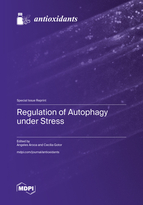Regulation of Autophagy under Stress
A special issue of Antioxidants (ISSN 2076-3921). This special issue belongs to the section "ROS, RNS and RSS".
Deadline for manuscript submissions: closed (30 November 2022) | Viewed by 36167
Special Issue Editors
Interests: Arabidopsis; autophagy; sulfide signaling; persulfidation; stress responses
Special Issues, Collections and Topics in MDPI journals
Interests: abiotic stress; autophagy; Arabidopsis; cysteine metabolism; sulfide signaling
Special Issues, Collections and Topics in MDPI journals
Special Issue Information
Dear Colleagues,
Autophagy is a conserved degradative mechanism essential for cellular homeostasis in eukaryotic organisms. Autophagy is a highly dynamic process that occurs at basal levels, and it might be induced to overcome cell stresses, playing a role in both physiological and pathological processes. The mechanism of autophagosome formation has been well characterized, and regulation of autophagy under different conditions is being widely studied. In animal systems, the importance of autophagy regulation is linked to its involvement in biologic processes such as aging, neurodegeneration, cardiovascular diseases, and cancer. In plants, autophagy is involved in development, immune response, and senescence, but it is also induced in response to stress conditions, such as nutrient starvation, pathogen attack, or other abiotic stresses. However, the understanding of the molecular mechanisms of autophagy regulation is still in significant development, including the involvement of gasotransmitters and small signaling molecules, such as those produced under ROS, RNS and RSS. Therefore, further insights into the regulatory mechanism of autophagy under stress are required to improve the development of therapies and strategies for overcoming the challenges from environmental stresses.
Dr. Angeles Aroca
Dr. Cecilia Gotor
Guest Editors
Manuscript Submission Information
Manuscripts should be submitted online at www.mdpi.com by registering and logging in to this website. Once you are registered, click here to go to the submission form. Manuscripts can be submitted until the deadline. All submissions that pass pre-check are peer-reviewed. Accepted papers will be published continuously in the journal (as soon as accepted) and will be listed together on the special issue website. Research articles, review articles as well as short communications are invited. For planned papers, a title and short abstract (about 100 words) can be sent to the Editorial Office for announcement on this website.
Submitted manuscripts should not have been published previously, nor be under consideration for publication elsewhere (except conference proceedings papers). All manuscripts are thoroughly refereed through a single-blind peer-review process. A guide for authors and other relevant information for submission of manuscripts is available on the Instructions for Authors page. Antioxidants is an international peer-reviewed open access monthly journal published by MDPI.
Please visit the Instructions for Authors page before submitting a manuscript. The Article Processing Charge (APC) for publication in this open access journal is 2900 CHF (Swiss Francs). Submitted papers should be well formatted and use good English. Authors may use MDPI's English editing service prior to publication or during author revisions.
Keywords
- Autophagy
- Biotic and abiotic stresses
- ROS, RNS, RSS








